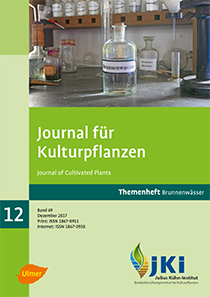Elemental composition of German well waters: Part 2 – Significance of the hydrogeological origin
DOI:
https://doi.org/10.5073/JfK.2017.12.02Keywords:
Hydrogeological classification, well water, water quality, major and trace elementsAbstract
Classifications group items according to common characteristics. For well waters, these are in particular characteristics of stratigraphic and hydrogeological origin, and hydrogeochemical typecast. It was the objective of this study to analyse, to which extent hydrogeological classifications may yield additional information on the elemental composition of waters. The experimental basis of this study was a database of the elemental composition of 637 German well waters of known hydrogeological origin maintained by the Institute for Crop and Soil Science, Julius Kuehn-Institut in Braunschweig, Germany.
Results show that after standardisation of the analytical data, high concentrations of I can be expected in waters from wells of regions with unconsolidated sediments which can be typically found in the northern lowlands of Germany. The content of As, Ca, K, Mo, S, Se, U and Y proved to be highest in water drawn from aquifers of slightly diagenetically modified bedrock found in low mountain ranges. In contrast, the highest contents of B, Cs, Er, F, Ge, Hf, Hg, La, Li, Lu, Nb, Ni, Rb, Si, Yb und Zr occur in water from wells in strongly diagenetically modified strata and crystalline bedrocks, for instance in the Harz and Rhenish Slate Mountains. The latter can be found in the middle-western and middle-eastern parts of Germany. Since essential macro- and micro-nutrients, beneficial elements as well as potentially toxic elements are introduced to soils irrigated with well water it is recommended to calculate element-specifically loads for assessing possibly associated beneficial and detrimental effects on plants, soils and groundwater.
Downloads
Published
Issue
Section
License
The content of the journal is licensed under the Creative Commons Attribution 4.0 License. Any user is free to share and adapt (remix, transform, build upon) the content as long as the original publication is attributed (authors, title, year, journal, issue, pages).
The copyright of the published work remains with the authors. The authors grant the Journal of Cultivated Plants, the Julius Kühn-Institut and the OpenAgrar repository the non-exclusive right to distribute and exploit the work.







